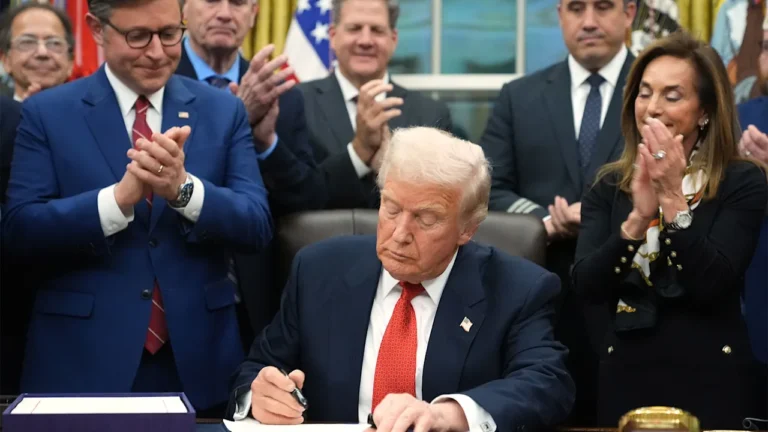
Denying reality is one of the most persistent, successful strategies in Donald Trump’s playbook. It helped him inject ambiguity into an electoral defeat in 2020, dismiss his surging unpopularity more broadly, and contend he never said things he actually said on live television.
Some aspects of reality, however, are simply undeniable, such as the amount of money in one’s bank account and how far it will go at the supermarket. Nevertheless, since Democratic politicians like Zohran Mamdani won big on November 4 with a message of affordability, Trump has been falsely insisting America has seldom been more affordable than it is right now. It’s a messaging strategy that may prove an even bigger miscalculation than Trump’s galactically fuzzy tariff math.
“The reason I don’t want to talk about affordability is because everybody knows that it’s far less expensive under Trump than it was under Sleepy Joe Biden,” Trump said on November 7 during a summit with Hungarian Prime Minister Viktor Orbán. The president has also insisted recently that “every price is down,” “gas is nearly $2,” and energy and inflation are both “way down.”
It should go without saying, of course, that none of this is true. And even some of the president’s historically reality-challenged supporters are taking notice.
High prices are getting harder to hide
Grocery prices are up, with record costs for beef and coffee. Gas prices are hovering around $3, having not come close to $2 since March 2020. Electricity bills are up 11%, and inflation in October 2025 was at 3%—up from 2.6% a year prior. Also, while Trump keeps touting Walmart’s reduced price on its Thanksgiving dinner this year, he refuses to acknowledge the sale is due to the company including less food in this year’s meal and a higher proportion of products from its Great Value private brand compared to name brands. (When an NBC reporter asked Trump about this discrepancy, he dismissed her question as “fake news.”)
As the high-spending holiday season approaches, and as people prepare to watch their health insurance premiums rise, it’s only going to get harder for Trump to maintain his sunny economic forecast without his supporters noticing the thunderstorms just outside their own financial window. It might temporarily help Trump’s case that due to the government shutdown the U.S. will have to wait a while to get fresh economic data. Still, plenty of other economic indicators abound.
The labor market appears to be weakening amid slow job growth and massive layoffs. Consumer sentiment has slumped to its lowest levels since mid-2022—around the time inflation hit a 40-year high under Biden. The share of first-time homebuyers has fallen to a record low of 21% this year. Even Trump’s Treasury secretary, billionaire hedge fund manager Scott Bessent, conceded “There are sectors of the economy that are in recession,” which may or may not have earned him a private tongue-lashing for the ages. And one economic indicator that should especially concern the president is the uncharacteristically adversarial interview he faced on Fox News this week.
A new angle from Ingraham
Laura Ingraham is typically one of Trump’s staunchest defenders on the network, where there is steep competition for the title. On November 10, though, she pushed back against the president’s claim that the economy is “as strong as it’s ever been,” asking why people are anxious about it if that’s the case. Elsewhere, she questioned the wisdom of his recent move to raise the 30-year mortgage to a 50-year one, and threw shade at the constellation of chintzy gold nonsense now festooning the Oval Office, asking whether it came from Home Depot.
Before getting too carried away with the significance of this interview, it should be noted that Ingraham went right back to vehemently defending Trump hours later. Not all Trump supporters will likely have their concerns as easily assuaged, though.
It would be one thing if Trump simply deflected blame for high costs in 2025. He could trot out any flavor of low-effort spin pinning high electricity bills and persistent inflation on those dastardly Democrats, whose unfair and possibly illegal shutdown wrecked an otherwise perfect economy. But doing so would mean acknowledging that his vast and sundry collection of campaign promises about bringing down prices have gone largely unfulfilled.
Faced with the prospect of accountability, he is instead once again denying reality. As of November 11, for instance, the White House was boasting about positive economic data cherry-picked from the inaugural DoorDash State of Local Commerce Report, citing its four-item “Breakfast Basics Index” with the mic-drop confidence of total vindication.
People of all political stripes will occasionally swallow lies from their leaders like bitter pills, but sticker shock tends to be spin-proof. Although the economic outlook was indeed rosy for Biden in 2024, the former president had a hard time conveying as much to people hit hard by inflation. The reality in grocery stores looked a lot different than what some economic forecasters were reading in the tea leaves, giving plenty of single-issue voters a case of cognitive dissonance.
But if Biden faced a vibecession, Trump could be fomenting a real one. The gulf has widened between what the administration is saying and what people are experiencing—and Trump’s cratering approval ratings suggest that those feelings are bipartisan. Whenever Trump finally switches gears from denying reality to casting blame, some of his cash-strapped supporters won’t buy it.
Believing the president might be something they literally can’t afford to do.

